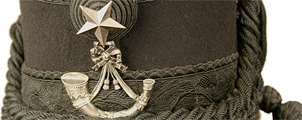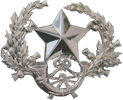Cameronians in the First World War – new display at Low Parks Museum
We have recently changed over our temporary display case at Low Parks Museum based on The Cameronians (Scottish Rifles) in the First World War. The new material focuses on the Gallipoli campaign and the Battle of Loos, in which several battalions of The Cameronians were engaged.
One item on display is the Distinguished Conduct Medal awarded to Private James Smith of the 7th Scottish Rifles. Private Smith was given the award for his bravery in assisting soldiers who had been wounded in an attack launched on 12th July 1915. This certificate from the museum collection describes Private Smith’s actions that day.
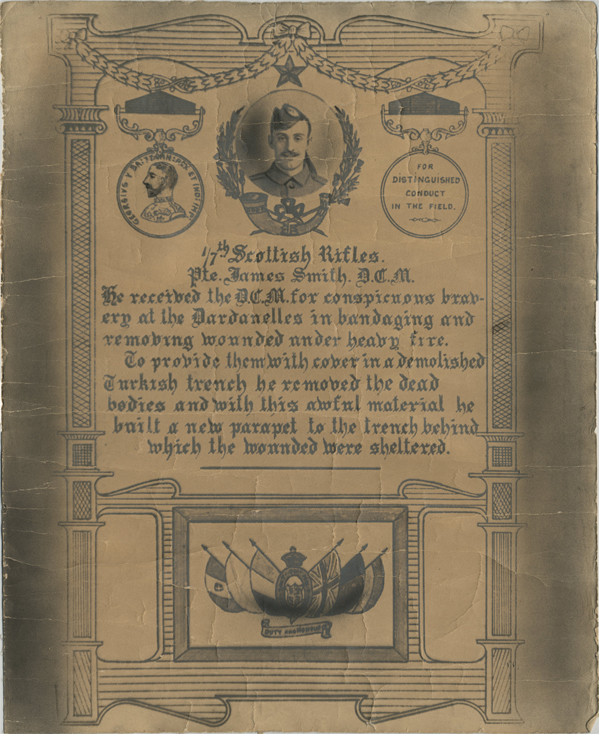
Certificate describing the events of 12th July 1915, that led to Private Smith being awarded the Distinguished Conduct Medal
Also on display is the battered old bugle carried throughout the War by the bugler of the 10th Battalion Scottish Rifles. The 10th Scottish Rifles arrived in France on 10th July 1915, as part of the 15th Scottish Division. Their first major action was at Loos on 25th September 1915, where they suffered heavy casualties in the attack on Loos village and the subsequent action on Hill 70. When the War had ended the bugle was presented to Colonel A. V. Ussher, the officer who had commanded the Battalion at the Battle of Loos, and where he himself had been badly wounded.
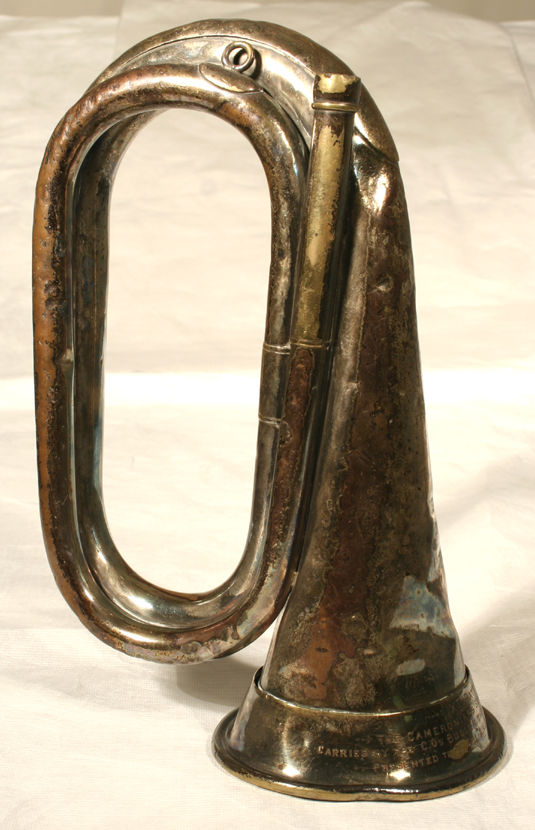
Bugle carried by the bugler of the 10th Scottish Rifles throughout the First World War
You can see these, and many more objects from the regimental collections of The Cameronians (Scottish Rifles), on display at Low Parks Museum, Hamilton.
Remember, you can also search and browse thousands of objects from the museum collection using our online collections website:
http://www.sllcmuseumscollections.co.uk/online_collection.jsp
Comments:
Remember Gallipoli
Sunday 28th June 2015 marks the 100th anniversary of one of the blackest days in the history of The Cameronians (Scottish Rifles). It was on that fateful day in 1915 that both the 7th and 8th Scottish Rifles attacked the Turkish trenches at Gully Ravine on the Gallipoli peninsula. The combined losses of the two battalions for that single day would never be equaled by the Regiment on any other day of the entire First World War. With this in mind it is rather unfortunate that the significance of the Gallipoli campaign has been largely forgotten, particularly in Scotland.
Both the 7th and 8th Battalions were Territorial Force battalions of The Cameronians (Scottish Rifles). Both battalions were based in Glasgow; the 7th Scottish Rifles had its headquarters at the old 3rd Lanarkshire Rifle Volunteer drill hall on the corner of Copelaw Street and Victoria Road (the building remains to this day), while the 8th Scottish Rifles were based out of the drill hall on Cathedral Street, now part of the grounds of the University of Strathclyde. Most of the officers and soldiers of these battalions were Glasgow-men, living and working in the city and the surrounding area. As Territorial soldiers they would regularly meet at headquarters for drill, and attend yearly camps where they would take part in field training and musketry practise.
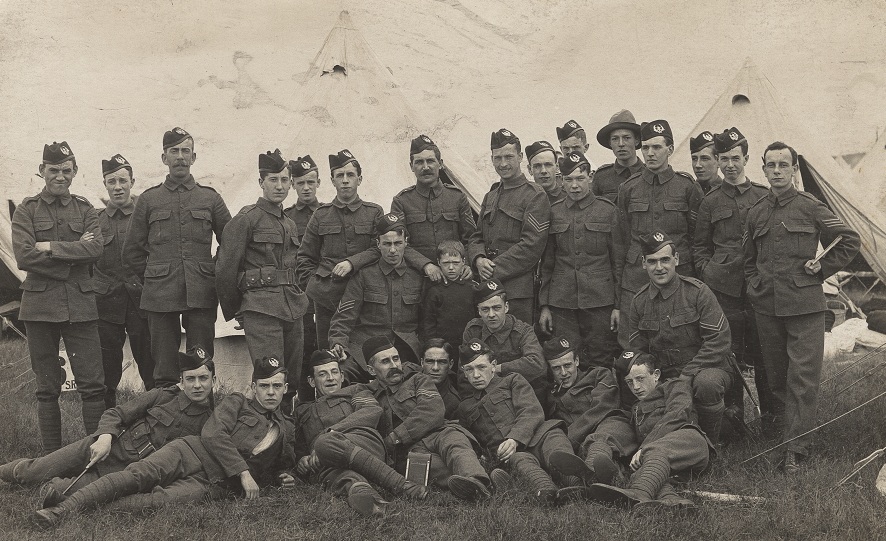
Men of the 7th Scottish Rifles at a pre-war Camp
The Territorial Force wasn’t ever intended to be used as part of an Expeditionary Force abroad; in the event of a large war these soldiers were to be used for home defence, freeing up regular battalions to take the fight to the enemy. By the end of 1914 the situation had changed and several Territorial battalions (including the 5th Scottish Rifles) were already fighting on the Western Front. So it was that the 52nd Lowland Division (comprised entirely of Scottish Territorial soldiers) found itself en route to Gallipoli towards the end of May 1915.
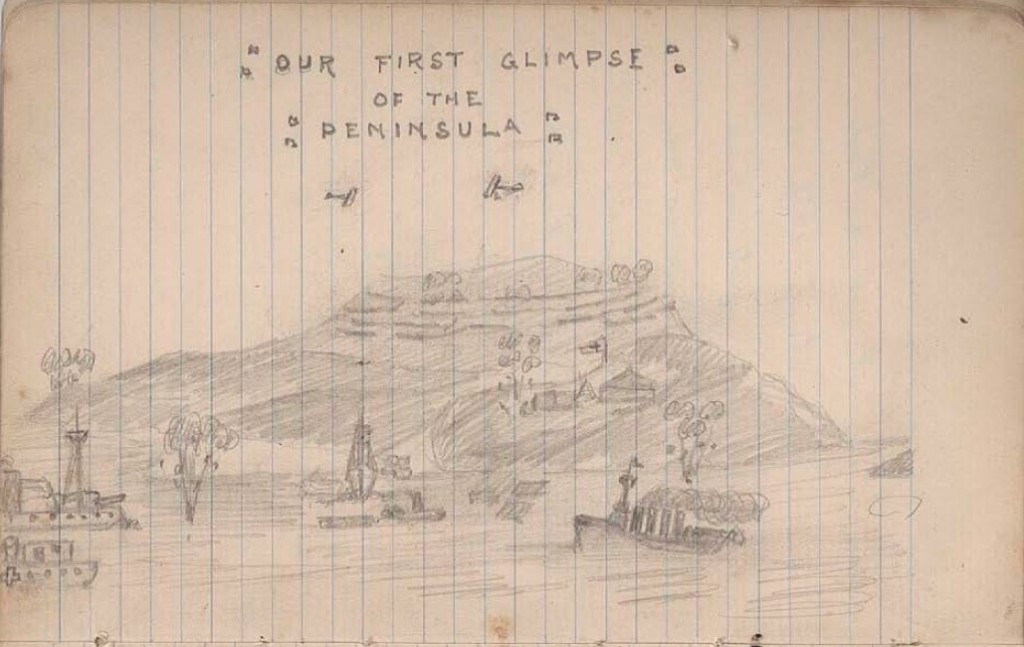
‘Our First Glimpse of the Peninsula’ by Private C. R. Bow, 7th Scottish Rifles
The 7th and 8th Scottish Rifles formed part of the 156th Brigade of the 52nd Lowland Division; both battalions landing at Cape Helles, Gallipoli, on 14th June 1915. The very next day they suffered their first casualties as a result of shelling from Turkish heavy guns, and from sniper and rifle fire. On 21st June the 8th Battalion suffered a heavy blow when their Commanding Officer, Colonel H. M. Hannan, was killed by a sniper.
On 27th June, orders were received for a large scale attack the next day. The 156th Brigade would form the right-flank of the attacking force; the 8th Scottish Rifles were to be one of the battalions in the initial assault, with the 7th Scottish Rifles close behind as Brigade reserve. The attack was to be preceeded by a short artillery bombardment of the Turkish defences. Unfortunately for the men of the Scottish Rifles, and unbeknown to them at the time, there would be no bombardment of the trenches they were tasked to capture.
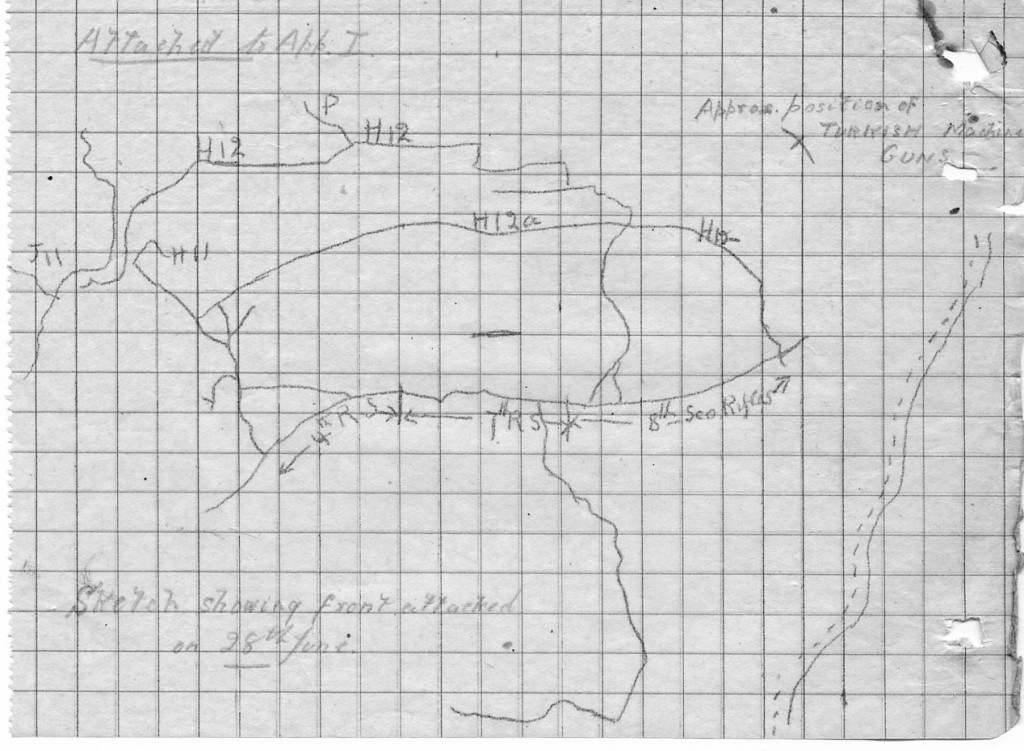
Sketch map showing the area attacked by 156th Brigade on 28th June.
Major J. M. Findlay, who had taken command of the 8th Battalion on the death of Colonel Hannan, described the attack:
Prompt at 1100 the whistles blew, and up and over went Nos. 1 and 3 Companies, followed almost immediately by No.2 Company. Five minutes after they had started they were practically wiped out, and No. 4 Company from the support trench had also suffered severely even before they reached our front trench…there was a ridge running between our line and the Turks’ front line, having crossed which every advancing man was subjected to a deadly fire from right, front, and left, and it was when each successive wave advancing topped this rise that line after line was enfiladed and mown down. Very few men reached the Turkish trenches, and those who did were either killed or wounded, with the exception of one or two men who managed to crawl back to our trenches during the night.
Many of the casualties suffered that day were caused by a Turkish machine gun, sited on the extreme right of the 156th Brigade’s advance. The lack of artillery support on this side of the attack was telling; had the machine gun been knocked out before the men advanced they might well have taken the Turkish trench and with lighter casualties.
Shortly after the 8th Battalion’s attack was stalled by the heavy fire laid down by the Turkish defenders, Major Findlay led a support group to try and gather up survivors and lead them on. This group made it to within around 50 yards of the Turkish trench when Findlay was also hit, shot through the neck. Amazingly, Findlay survived. Captain Bramwell, the adjutant, was not so lucky – he was killed by Findlay’s side – nor was 23 year-old Lieutenant Stout, the signalling officer, who was killed by a shell splinter as he tried to drag Major Findlay to safety.
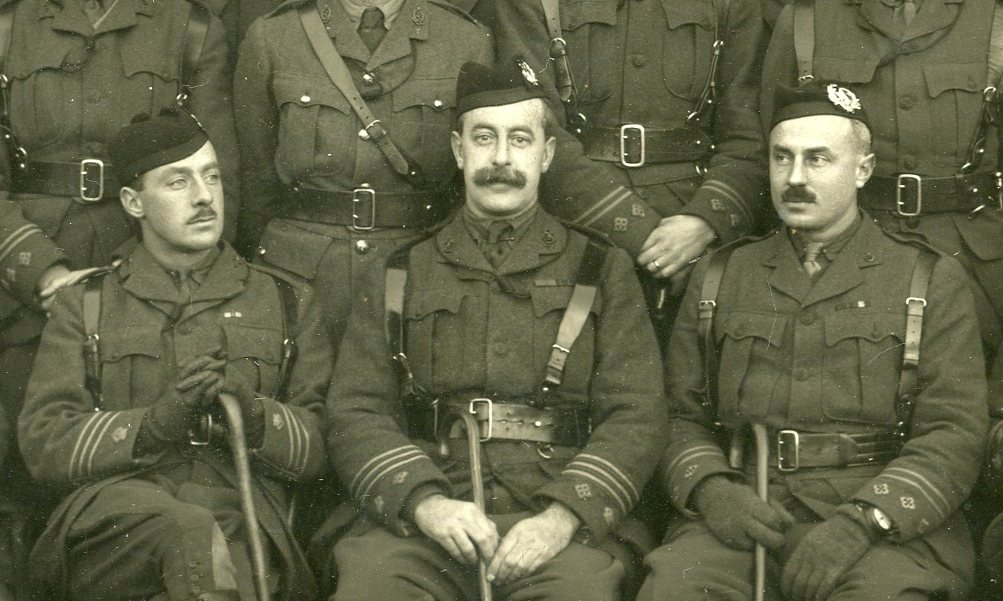
Major Findlay, Colonel Hannan, Captain Bramwell
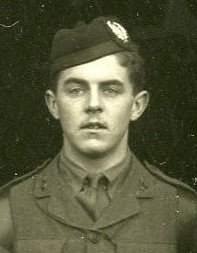
Lieutenant Stout
There was no shortage of bravery that day. When it was discovered that one of the few surviving officers of the 8th Scottish Rifles, Lieutenant Tillie, was lying wounded out towards the Turkish lines, Sergeant Miller risked his own life to save him. He succeeded in bringing the wounded officer back to the British trenches. Sergeant Miller never received any gallantry medals for his actions that day, but after the War Lieutenant Tillie did present him with a handsome pocket watch as thanks for saving his life that day.
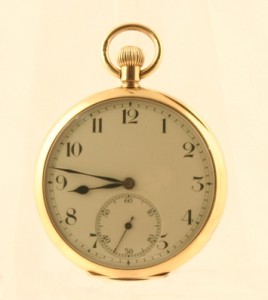
Pocket watch presented to Sgt. Miller
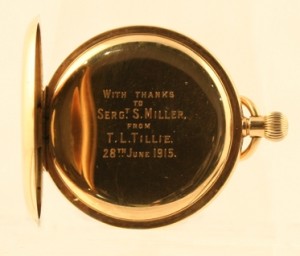
Inscription inside the pocket watch
The 7th Scottish Rifles, who were in reserve when the attack started, were soon sent forward to reinforce the assulting force. They too were caught up in the heavy rifle and machine gun fire laid down by the Turkish defenders. While their casualties were not quite so high as the 8th Battalion, they too were badly mauled in the attack. The Commanding Officer of the 7th Scottish Rifles, Colonel Boyd-Wilson, was killed while leading the battalion forward. Many more officers were killed and wounded, command falling onto junior officers and sergeants. The Turkish line was taken in places, but enemy reinforcements made it almost impossible to consolidate any gains that had been made.
At one point in the action a Turkish grenade fell into a section of trench packed full of men of the 7th Scottish Rifles. Lance Corporal Ross and Private Young, realising the devastation the grenade would cause in such a confined space occupied by their comrades, tried to stifle the effects of the blast. Lance Corporal Ross put his foot on the grenade while Private Young bundled up a greatcoat and held it over the grenade with his hands and body. The grenade exploded, badly injuring the two men, but saving their comrades from harm. For their actions both Lance Corporal Ross and Private Young were awarded the Distinguished Conduct Medal.
In the early hours of 29th June, the survivors of the 7th and 8th Scottish Rifles were relieved and withdrawn to the reserve lines. The next day was spent trying to clear as many wounded and dead from the front line trenches as was possible. It was then that the enormity of the losses sustained by the two battalions became apparant. A roll call on 30th June revealed that the 7th Scottish Rifles had lost 14 Officers and 158 Other Ranks killed or missing, with a further 104 men of all ranks being wounded. The 8th Scottish Rifles had sustained terrible losses – 15 Officers and 334 Other Ranks killed or missing, and 124 men of all ranks wounded. The majority of those reported as missing were never seen again, most likely killed or having died of wounds. Among those killed was a young Private called John Gray of the 7th Scottish Rifles. The day before the attack he had written to his mother in Glasgow; it would ultimately be his last letter home:
…Well Mother about myself, I’m keeping A1 now, and pushing through this life as best I can. It’s not a pleasant one, but it’s got to be done. Things have been very quiet here lately, but as the saying goes “there’s always a calm before a storm.” We’ve been resting now since Thursday, so that I think we’ll be going back to the trenches tonight. Well Mother, as there’s nothing more to say at present Ill start summing up, give my best love to Liz and all at home, and tell all my friends I was asking for them… I’ll draw to a close now, with the hope that it won’t be many weeks or months before we’re sailing back to Bonnie Scotland.
The next time one hears the name ‘Gallipoli’ spare a thought for the thousands of soldiers from all countries who fought and died there in the First World War, and remember the hundreds of men of The Cameronians (Scottish Rifles) who fell at Gully Ravine.
Comments:
British Army ration biscuits
Army issue biscuits or ‘hard tack’ have been a staple part of ration packs throughout the history of the British Army. Within our collections at South Lanarkshire Leisure and Culture we have three such biscuits. One is wrapped in the pages of The Glasgow Herald dated 13th October 1900 and dates from the Boer War. The second dates from the early 20th century, most likely from the First World War and the third is from the Second World War.
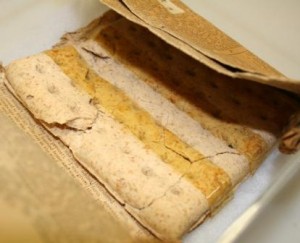
Ration biscuit from the Boer War wrapped in pages of The Glasgow Herald dated 13th October 1900.
During the First World War British troops consumed approximately 4,500 calories a day. Whilst this sounds a substantial amount, food at the front was often poor quality and rations could be sporadic. Feeding an army was logistically, a complex task. Supply lines were often affected by fighting and shortages were prevalent. By the end of First World War there were over 2.3million men at the Western Front alone. The food supplied was often monotonous and at times inedible, however, in comparison to French and German troops, the British were believed to have been relatively well fed.
There was no official standard army ration during the First World War but all men received roughly the same allowance. Colonel H.H. Story M.C. states in The History of the Cameronians (Scottish Rifles) 1910-1933 that the rations issued to the 19th Infantry Brigade during the winter of 1914-15 were as follows,
Bread/Biscuit: 1lb
Meat: 12oz
Vegetables: 8oz
Bacon: 4oz
Sugar: 3oz
Jam: 4oz
Butter/marg: 2oz
Cheese: 3oz
These were issued daily with the exception of butter which soldiers received twice a week. Meat was usually tinned known as ‘Bully beef’ or issued as the infamous ‘Maconochie,’ a mixture of fatty meat, vegetables and gravy. The food often had to be eaten cold and the men had to prepare their meals themselves whilst at the front. Bread was scarce, particularly in 1916 when there was a flour shortage. Men often had to resort to ‘biscuits’ made from salt, flour and water. In 1914 Huntley and Palmers were contracted by the British government to produce the No.4 standard Army Biscuit, so called as it was approximately 4 inches square. At the time Huntley and Palmers were the world’s biggest biscuit manufacturer and had even supplied Captain Scott with biscuits on his expedition to the Antarctic in 1911.
These ‘hard tack army biscuits’ were incredibly tough and often had to be soaked in tea or water for some time before consumption. Sometimes they were ground down to use as a thickening agent (known as ‘duff’) for stews. Other men found more novel uses for the humble but durable biscuit. Some used them as postcards by writing messages on the surface and posting them home to arrive at their destination intact. Others used them as a blank canvas to paint or draw on, but perhaps one of the most popular uses was as a photo frame. The frame was created by carving out the centre and placing a photograph in the hollow.
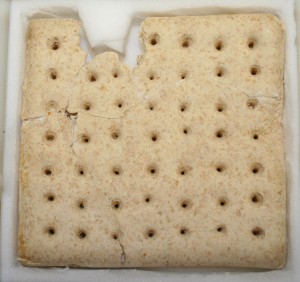
Biscuit from the early 20th century, possibly First World War 1914-18.
Whilst many found humour in the hard tack biscuits others were angered by the poor quality food that they received. One biscuit in the collections of the Imperial War Museum, North bares the handwritten message, “YOUR KING AND COUNTRY NEED YOU AND THIS IS HOW THEY FEED YOU.”
The fact that so many of these biscuits survive today, 100 years after their production, is testament to their durability and perhaps the incredulity of many men who kept these biscuits not only as mementos but as physical evidence of the diet that they were subjected to.
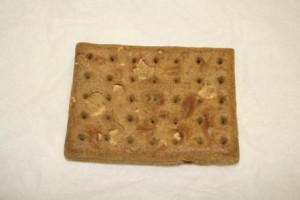
Iron ration biscuit from the Second World War 1939-1945.
Comments:
Private James Towers VC
The Victoria Cross medal group to Private James Towers VC, 2nd Battalion The Cameronians (Scottish Rifles), sold at auction yesterday (Wed 25th March) with a hammer price of £120,000. Private Towers was the last of three soldiers of the Regiment to be awarded the Victoria Cross for service in the First World War, and was in fact the last Cameronian to earn the famous award.
The war diary of the 2nd Battalion for 22nd December 1918 reads:
“One of the greatest days in the history of the Battalion. At about 10.00 hrs a wire came in stating that the VICTORIA CROSS had been awarded to PTE. JAMES TOWERS of B Company for an Act of the most unsurpassed bravery performed by him on the 6th Oct. this year.”
We are fortunate to have in the museum collection the very signal that was received that day notifying the Battalion of the award of the VC to Private Towers. The signal was taken by Private Harry Podmore, one of the Battalion signallers, and was kept by him as a souvenir. At some point, Private Towers has signed the signal ‘Pte. J. Towers V.C.’
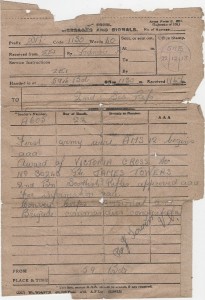
Signal Message, 2nd Battalion Scottish Rifles, dated 22nd December 1918
The war diary for that day continues:
“The Pipe Band were paraded and played PTE TOWERS from Battalion Hdqrs through the village to his billet. He was carried shoulder high by a party of his own platoon & received a great ovation from the whole Battalion.”
With the fighting only ending a matter of weeks earlier, on 11th November, the men truly had reason to celebrate news of the award.
You can browse and search for more fascinating objects in the museum collection by using our online Collections Browser – http://www.slleisureandculture.co.uk/SLLC/info/206/online_collection
Comments:
Christmas in the trenches with The Cameronians (Scottish Rifles)
As we commemorate the 100 year centenary of the First World War the collections team here at South Lanarkshire Leisure and Culture have been sorting through all the objects and archive we have relating to the First World War. During this process we have come across a number of poignant and interesting objects relating to Christmas in the trenches.
For most soldiers Christmas Day in a theatre of war would be like any other day perhaps with the added bonus of a few extra cigarettes or cakes to share amongst them. December 1914 in France also saw very cold, wet and muddy conditions so men would have struggled to stay dry and warm for long. These photographs from the museum collection show officers of the 1st and 5th Battalions in the trenches on Christmas Day 1914 with Captain T. R. McLellan playing the bagpipes for the men and Private Coghlan doing his best to cheer up the men by dressing up.
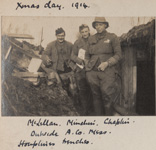
Christmas day in the trenches

McLellan final image

Rfn Coghlan final
There has been much mention recently of the Christmas Truce of 1914, when soldiers of the British Army and German Armies observed a truce for Christmas Day and met in no-man’s land to exchange gifts and play football. The truce was not observed everywhere along the Western Front and fighting continued in many places. Extracts from the war diaries, which have been fully transcribed by our volunteers, The Friends of Low Parks Museum, show that of the three battalions of The Cameronians who were out in France by December 1914, the 1st and 2nd Battalions carried on as normal. The 1st Battalion reported: “Enemy very noisy during night. One man wounded.” The 5th Battalion however reported: “Very little sniping, almost an understanding not to fire but one man killed by a sniper”. The 5th Battalion History book elaborates on this saying:
“On Christmas Eve we could hear the Germans (XIXth Saxon Corps) celebrating the advent of Christmas by singing and merrymaking. We could also hear a brass band behind the houses in their lines playing Christmas carols. For roughly twenty-four hours, Christmas Eve to late afternoon on Christmas day, they ceased firing at us, and we reciprocated. An attempt at fraternisation took place on Christmas day, ” Jerry ” leaving his trench unarmed. Certain souvenirs were exchanged and, if it had been left to the soldiery of both sides, the war would there and then have been declared a draw. But towards late afternoon on Christmas day a stray shot from our right front hit one of ours, No. 6 I 79, Corpl. W. S. Smith, No. 2 Company (from which he died next day). The Saxons opposite us were at pains to let us know that it was a Prussian who had fired the shot which killed Smith. This broke the spell, however, and the war was resumed after a tacit truce of twenty four hours. This truce drew forth an army routine order reminding us that we ‘were in France to fight and not to fraternise with the enemy.”
Christmas could be a lonely time for soldiers when thoughts would turn to loved ones at home. Friends and families would send letters and parcels to the men at the front and often soldiers would send embroidered postcards like the one below to their beloved.

Christmas embroidered postcard final
We recently came across the postcard below in the collection. Writing home to the daughter he has yet to meet, Rifleman Davidson wishes her a “merry merry Christmas…and a merrier and prosperous New Year.” Unfortunately we have been unable to track down exactly who Rfn Davidson was and if he did indeed survive to meet his new daughter. If you have any information which could help us with this then please do let us know.

Rfn W Davidson Xmas Card front final

Rfn W Davidson Xmas Card back final
Comments:
Log in

